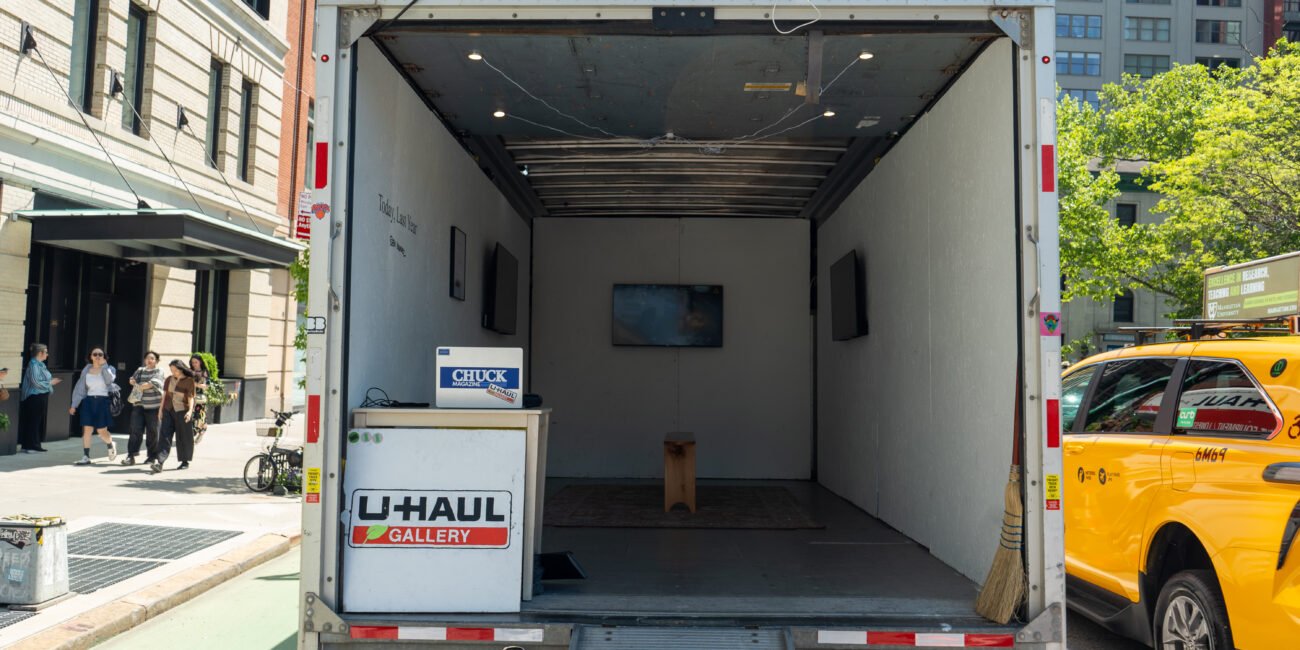
During the jam-packed New York art week, you may have spotted a nondescript U-Haul truck parked outside any one of the city’s main fairs or high-profile gallery openings. It stands to reason—U-Haul, with its relatively affordable van and truck rentals, has a role to play in the art market. If, however, you think that role is necessarily logistics, prepare to be surprised. In a week dense with art and spectacle, we ducked out of an overcrowded Michael Armitage opening at David Zwirner to see what exactly was drawing an audience to one such truck—its cargo bay wide open and people drifting in and out, sometimes with beers in hand.
What we found was U-Haul Gallery, a nomadic initiative experimenting with an alternative mobile model for showing and circulating art while sidestepping the punishing overhead of brick-and-mortar space in the city. “The gallery was born out of frustration with the cost of space in New York City,” director and founder James Sundquist told Observer.
The busy week of art fairs marked the one-year anniversary of this slyly resourceful gallery, which has been able to deliver programming to virtually any hot pocket of real estate for the modest price of a truck rental—$29.99 per day. “The very first show took place in SoHo, to reclaim a space historically home to many artists who have since been priced out,” Sundquist said. “With this truck, we create a temporary architecture to enact the gallery.”


The inaugural show was conceived as a one-off: more performance art than actual gallery. However, the audience response was unexpectedly enthusiastic, according to Sundquist, which gave them the confidence to keep going. “I think people enjoy the freedom of it—the punk quality, the sense that the bounds of the art world can be disrupted in a guerrilla fashion,” he said, adding that artists have embraced the gallery’s approachability and agility, often becoming co-conspirators in shaping the exhibition as it unfolds. “There is always a plan, but the plan always changes. We can adapt to the situation on the ground in ways a stationary gallery cannot.”
Since its founding, U-Haul Gallery has staged several shows, mostly timed with New York’s better weather. Last October, Sundquist teamed up with Jack Chase and Victoria Gill for “The Show of Stolen Goods,” marking the first time outside curators took the wheel. “Jack and I developed an incredible synergy during that show, and I felt together we could keep pushing the gallery into new terrain,” he said. Following that collaboration, Chase officially joined the gallery as head of global strategy. “We’ve since been partners in crime.”
When it comes to programming, Sundquist reflected that the gallery is writing its story as it goes. “We attract artists who are interested in exploring outside the traditional gallery space—physically, but also mentally and spiritually. The artists want to work in the alternative conditions of the U-Haul, and we develop a collaborative approach to each show.”
SEE ALSO: Satellite Collective’s Kevin Draper and Lora Robertson On Making Art in Turbulent Times
The show they presented last week was a sharp testament not only to their collaborative model but also to their knack for problem-solving and real-time adaptability. Playing across multiple screens mounted in the back of the truck was Ben Nuñez’s conceptual video work Today, Last Year, featuring four days from his Panopticon endurance project, in which he recorded his waking life for an entire year using an AXON police body camera. In these videos, Nuñez captures the flat banality of daily life with an unflinching intimacy—disturbing, solipsistic and shot through a device more commonly associated with social violence than self-reflection. Echoing Foucauldian thought on the embodiment of power structures and the internalization of surveillance, the project interrogates the entangled relationship between digital media, social codes and identity construction, dissolving the boundary between self and screen until the online double feels more real than lived experience.
“It was a conceptual video show that presented new technical challenges,” Sundquist said, citing the screens’ power requirements and the logistical quirks of outfitting a U-Haul to present screen-based works. “We arrived at a presentation that really resonated with the audience. We want to do shows that will challenge us.”








No Comment! Be the first one.